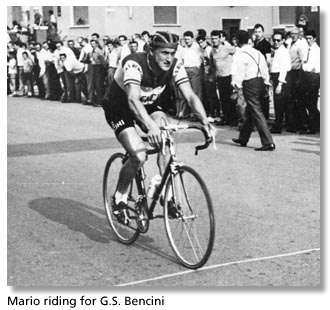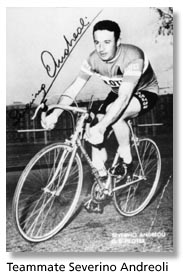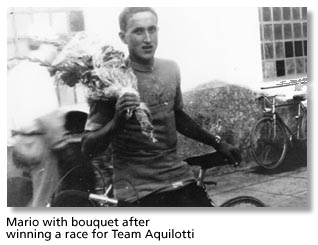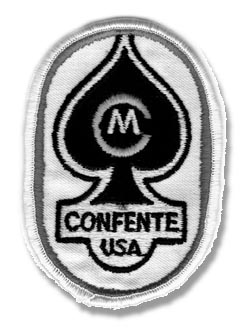 Mario Confente is certainly one of the finest frame
builders that ever put a torch to steel. Tragically, Mario died on March
8, 1979 at the young age of 34. He left behind a legacy that includes 135
frames bearing his name. Most frame builders spend years and build a
thousand frames to achieve the recognition that Mario garnered in such a
short time. The respect that he achieved is a testament to his devotion
and passion for the bicycle. His standard was nothing short of perfection.
As a result, Mario began working at an early age. He first served as an
apprentice in a hardware store. His mechanical aptitude soon captured the
attention of a family friend, Mr. Tiberghien, who gave Mario a job in his
wool factory. Mario worked as a mechanic and often repaired the looms. As
he grew older, he furthered his mechanical education by attending the
state trade school, the Leonardo Da Vinci. Displaying his artistic side,
he also made religious crosses which he sold to the Vatican.
Like most young Italian boys, Mario was captivated by bicycle racing.
He was just thirteen when he joined the Aquilotti club, his town's local
club. His prowess on the bike was evident due to his numerous victories.
At the age of fifteen, he won the provincial championship as a junior
while riding for the Gaiga club.
When he turned eighteen, the Bencini bike club invited Mario to join
their ranks. The Bencini team was the best Dilettanti (semi-pro) team of
that period. Local riders from Verona filled the squad's roster. The
director sportif was Guido Zamperioli. From 1963 to 1966, the Bencini
squad members produced impressive results:
Due to the demands of this higher level of competition, Mario chose to
quit his job and race full-time. Soon he was traveling with the team to
Torino, Milano and Switzerland. He supplemented his income by building
frames. Mario's father urged him to give up racing because it paid poorly
and the risks were high. His father even remodeled a small workshop
adjacent to their home to enable Mario to build frames. Soon, he built
himself his first frame. Before long, his teammates were requesting frames
as well.
Renzo Ferrari, another teammate of Mario's from the Bencini club
remembers, "I met Mario when I was 17 and he was 16. We were in a gym and
we became friends even though we raced for different clubs. Mario was of
good character and he got along with everyone even when he was racing. He
was generous and highly esteemed for his passion of cycling. He
distinguished himself from the other fellows for the attention,
maintenance and care that he had for his bicycle." He adds, "Mario was
always adjusting my bicycle and he even taught me how to pick wild
mushrooms!"
In 1963, during a race, Renzo and Mario broke away together and rode
the last 20 km together. Renzo won the race and Mario had to settle for
second. However, they remained friends long after. Bencini rider and
former World Champion, Pietro Guerra recalls, "Mario did not win a lot of
races but he was strong, generous, and always ready to help everyone."
Pietro Guerra remembers, "When Mario stopped racing, he didn't know
what to do. The passion he had for the bike was still strong so he learned
right away how to build racing frames. He became a specialist in building
racing frames and to make himself known in the field he gave me a track
bike. It was a real jewel! With it, I won three Italian professional
individual pursuit championships, 1970 at Varese, 1971 at Milano, and 1972
at Bassano del Grappa."
From 1968 to 1970, Mario continued to build frames in his home
workshop. During this period, Ditta Bianchi asked him to build frames for
his company under a piece work agreement. Soon, Mario had more work then
he could handle by himself. He quickly outgrew his facility. In 1970,
Mario hired several apprentices and was forced to relocate his frame
building business. The new shop, though modest, was expansive and he lived
above it in a small apartment with his parents.
His reputation continued to grow and Pietro Guerra adds, "We presented
Mario to the famous Masi of Milano. In the beginning, Masi brought work to
Verona for Mario. At the time the bike market was slow in Italy, so with
the Masi project he transferred to California in search of better luck."
In the early seventies, the US experienced an energy crisis and a
subsequent bicycle boom. Roland Sahm, a wealthy business man from San
Diego contacted every Italian bicycle manufacturer on licensing their name
and building frames in the US. According to Sahm, Cinelli, Colnago and
Bianchi all refused him. However, one Italian bicycle manufacturer
recognized the potential of the growing US market. Falierio Masi sold Sahm
the rights to produce a Masi bicycle in the U.S.
Mario arrived in Los Angeles in October 12, 1973. As evidenced by the
following letter he did not expect to stay long. Dated October 21, 1973,
Ernesto Colnago wrote to Mario in California:
Dear Mario, Next Issue - the Confente Story continues in the U.S.
Special thanks to Chuck Schmidt for a copy of the Colnago letter.
|
 Mario
Confente was born January 29, 1945 in Montorio, Italy, a small town a few
miles from Verona. He was the third of five children and the only male
child. His sister Gianna Confente recalls, "his infancy was not rosy
because we were a modest family and only our father was working. It was a
difficult period following the war."
Mario
Confente was born January 29, 1945 in Montorio, Italy, a small town a few
miles from Verona. He was the third of five children and the only male
child. His sister Gianna Confente recalls, "his infancy was not rosy
because we were a modest family and only our father was working. It was a
difficult period following the war."
 As a semi-pro, he placed well in several races and
even won a few. One teammate Severino Andreoli recalls, "Mario was a
strong rider, not too much of a winner but often among the first places of
the classification. He sacrificed a lot for the team during a break away
or to block, while a companion took a flight for victory."
As a semi-pro, he placed well in several races and
even won a few. One teammate Severino Andreoli recalls, "Mario was a
strong rider, not too much of a winner but often among the first places of
the classification. He sacrificed a lot for the team during a break away
or to block, while a companion took a flight for victory."
 While racing
on the velodrome in the fall of 1968, Mario sustained a severe injury from
a crash. Once he recovered, he gave up racing and threw his energy into
frame building. Mario's work was impeccable and his reputation grew,
thanks to his friends and teammates Pietro Guerra and Flaviano Vicentini.
Both riders won numerous races and World Championships on Confente built
frames.
While racing
on the velodrome in the fall of 1968, Mario sustained a severe injury from
a crash. Once he recovered, he gave up racing and threw his energy into
frame building. Mario's work was impeccable and his reputation grew,
thanks to his friends and teammates Pietro Guerra and Flaviano Vicentini.
Both riders won numerous races and World Championships on Confente built
frames.
 Although Colnago and Confente never engaged in a
joint venture, it would certainly have proved interesting. Confente did
build for the Masi California project and eventually built under his own
name. His impact on the U.S. bicycle market was profound and he quickly
established a new standard for U.S. custom builders.
Although Colnago and Confente never engaged in a
joint venture, it would certainly have proved interesting. Confente did
build for the Masi California project and eventually built under his own
name. His impact on the U.S. bicycle market was profound and he quickly
established a new standard for U.S. custom builders.